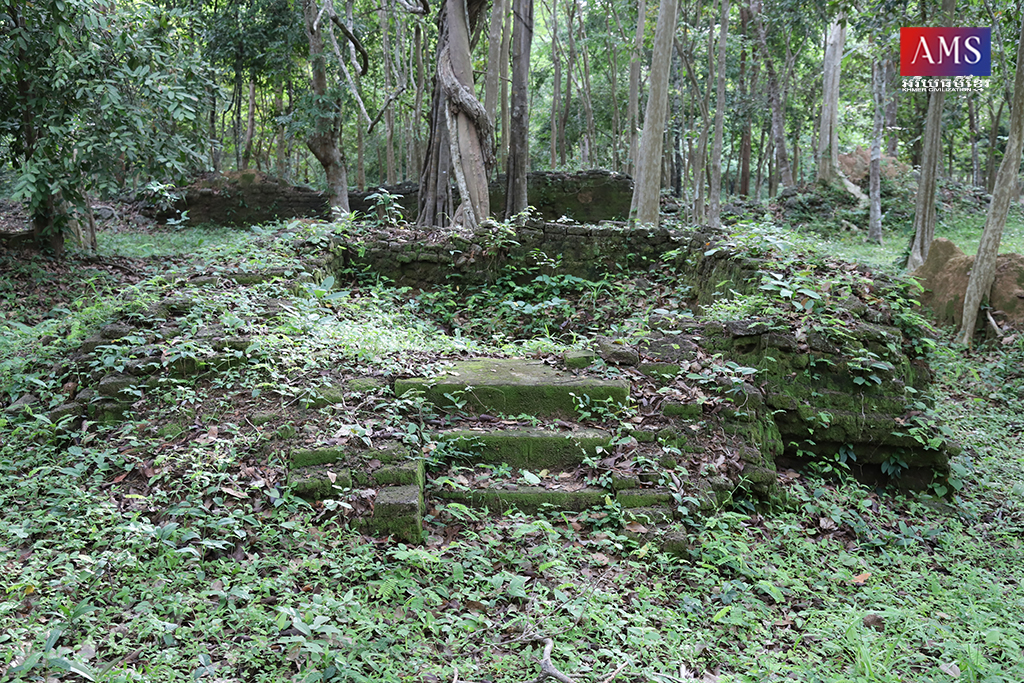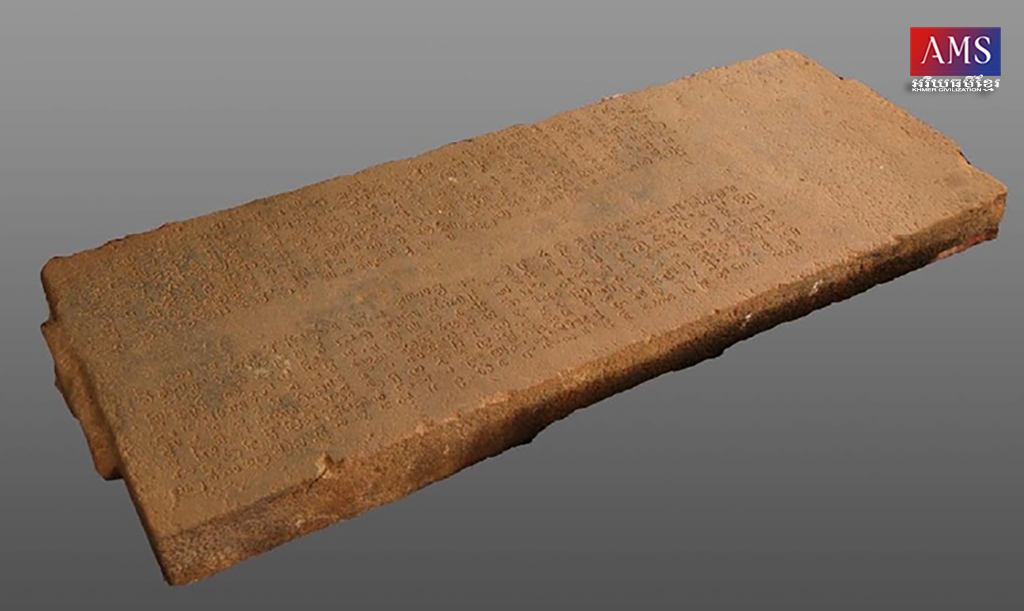ក្រុមប្រាសាទយាយព័ន្ធ ឬក្រុមខាងត្បូង គឺជាក្រុមប្រាសាទដ៏សំខាន់មួយនៅក្នុងតំបន់ប្រាសាទសំបូរព្រៃគុក។ នៅក្នុងក្រុមនេះមានប្រាសាទសរុបចំនួន ៣៥ ហើយតួប៉មដែលសំខាន់ជាងគេ គឺតួប៉មនៅកណ្តាល ចុះបញ្ជី ឧទ្ទិសដល់ព្រះឥសូរដែលមានព្រះនាមថា ឝ្រីប្រហសិតេឝ្វរៈ (Çrīprahasiteçvaraḥ) ឬមានន័យជាភាសាខ្មែរថា “ព្រះសិវញញឹម”។ ក្រៅពីតួប៉មកណ្តាល ក្នុងក្រុមប្រាសាទយាយព័ន្ធ មានតួប៉មប្រាសាទប្រាំបីជ្រុងចំនួន ៦ ទៀត ដែលជាស្ថាបត្យកម្មពិសេសល្អឯកមួយប្រចាំតំបន់សំបូរព្រៃគុក។ អ្វីដែលគួរកត់សម្គាល់ផ្សេងទៀតនោះ គឺក្រុមប្រាសាទយាយព័ន្ធ គឺជាក្រុមប្រាសាទមួយនៅតំបន់ប្រាសាទសំបូរព្រៃគុក ដែលសម្បូណ៌ដោយតួប៉មប្រាសាទសាងអំពីថ្មបាយក្រៀម។ ប្រាសាទថ្មបាយក្រៀមទាំងនោះមានចំនួន ៦ សង់នៅបរិវេណកំពែងខាងក្រៅ មានរាងបួនជ្រុងស្មើ បែរមុខទៅកើត និងសុទ្ធសឹងមានកំពែងព័ទ្ធជុំវិញគ្រប់តួប៉មទាំងប្រាំមួយ ហើយបើមើលទៅដូចជាតួប៉មរណបមួយឱ្យសំណង់សំខាន់ដែលនៅបរិវេណកំពែងខាងក្នុង។ ប្រាសាទថ្មបាយក្រៀមទាំងប្រាំមួយនេះ ចុះបញ្ជី S17-4, S17-5, S17-6, S17-7, S17-8, S17-9។ សំណង់ទាំងប្រាំមួយនេះ ភាគច្រើនបានបាក់បែកស្ទើរទាំងស្រុងទៅហើយ លើកលែងតែតួប៉មចំនួនពីរដែលនៅសល់រូបរាងគ្រាន់បើ ពោល គឺតួប៉មដែលចុះបញ្ជីលេខ S17-5 និង S17-6។ នៅទីនេះ យើងសូមលើកយកតែតួប៉ម S17-6 មកបរិយាយប៉ុណ្ណោះ ដ្បិតវាជាតួប៉មដែលសំខាន់ជាងគេក្នុងចំណោមតួប៉មប្រាសាទថ្មបាយក្រៀមទាំង ៦ នៅក្រុមប្រាសាទយាយព័ន្ធ ដែលគេអាចចាត់ទុកថា ជាសំណង់ប្រាសាទថ្មបាយក្រៀមដែលសង់ឡើងដំបូងៗនៅក្នុងសិល្បៈខ្មែរ។ តើប្រាសាទយាយព័ន្ធ តួប៉ម S17-6 មានលក្ខណៈបែបណាខ្លះ?
តួប៉ម S17-6 មានទីតាំងស្ថិតនៅខាងជើងតួប៉មកណ្តាលនៃក្រុមប្រាសាទយាយព័ន្ធ និងស្ថិតនៅក្នុងបរិវេណកំពែងខាងក្រៅ។ តួប៉មនេះ សាងឡើងអំពីថ្មបាយក្រៀម មានរាងបួនជ្រុងស្មើ ប្រវែង ៤,៥ម៉ែត្រ គុណ ៤,៥ម៉ែត្រ មានកំពែងព័ទ្ធជុំវិញធ្វើអំពីថ្មបាយក្រៀមដូចគ្នា បែរមុខទៅទិសខាងកើត។ សព្វថ្ងៃ តួប៉មនេះនៅសល់រូបរាងដើមត្រឹមពាក់កណ្តាល ដោយអាចនៅឈរត្រឹមកម្ពស់ ១,៥០ម៉ែត្រ ព្រមទាំងមានការលម្អជាក្បាច់ផ្សេងៗនៅឃឿនខាងក្រោម។ នៅប្រាសាទនេះ គេធ្លាប់រកឃើញផ្តែរទ្វារចំនួនមួយផ្ទាំង ឆ្លាក់បង្ហាញអំពីរូបសត្វមករនៅសងខាងបែរមុខចូលក្នុង និងមានលម្អក្បាច់មេដាយ៉ុងចំនួនបីឆ្លាក់ជារូបទេពផ្សេងៗដូចផ្តែរជាច្រើនទៀតនៅតំបន់សំបូរព្រៃគុកដែរ (រូបលេខ៥)។ អ្វីដែលធ្វើឱ្យអ្នកស្រាវជ្រាវកត់សម្គាល់ខ្លាំងអំពីតួប៉ម S17-6 គឺតួប៉មនេះធ្លាប់រកឃើញសិលាចារឹកមួយដែលចារនៅលើមេទ្វារប្រាសាទ ចុះបញ្ជីលេខ K.៦០៤ ចារនៅលើមេទ្វារមានចំនួន ៣០ បន្ទាត់ ស្មើនឹង ៣០ ស្លោក ចារឹកជាភាសាសំស្រ្កឹត ហើយសព្វថ្ងៃរក្សាទុកនៅសារមន្ទីរខេត្តកំពង់ធំ។ សិលាចារឹកនេះរកឃើញដំបូងដោយលោក Victor Goloubew ក្នុងឆ្នាំ១៩២៧ និងបានបោះពុម្ពផ្សាយបន្ទាប់ទៀតដោយលោក Louis Finot។ ក្រោយមកទៀត នៅឆ្នាំ១៩៥២ លោក George Coédès បានប្រែដោយសង្ខេបឡើងវិញម្តងទៀត។ លោក George Coédès បានបញ្ជាក់ថា សិលាចារឹកនេះ រៀបរាប់អំពីមន្រ្តីម្នាក់ដែលមានវិជ្ជាជ្រៅជ្រះខាងផ្នែកព្រះពុទ្ធសាសនាឈ្មោះ “វិទ្យាវិសេស” ហើយលោកក៏គិតទៀតថា សិលាចារឹកនេះជាសិលាចារឹកនិយាយរឿងពុទ្ធសាសនាចំណាស់ជាងគេនៅកម្ពុជា។ ក្រោយមក នៅឆ្នាំ ២០១៨ លោក កំ វណ្ណារ៉ា ក៏ធ្លាប់ប្រែសិលាចារឹកនេះទាំងស្រុងឡើងវិញម្តងទៀត។ ក្នុងឆ្នាំ២០១៩ លោក Dominic Goodall ក៏ធ្លាប់លើកយកសិលាចារឹកនេះមកសិក្សាម្តងទៀតក្នុងអត្ថបទមួយដែលចុះផ្សាយក្នុងឧទ័យ លេខ ១៤។ សិលាចារឹកនេះ ផ្តល់កាលបរិច្ឆេទមហាសករាជឆ្នាំ៥៤៩ ត្រូវនឹងគ.ស.៦២៧ ដែលត្រូវរជ្ជកាលព្រះបាទឦសានវរ្ម័នទី១ (គ.ស.៦១៦ ដល់ ៦៣៧)។
សិលាចារឹកនេះចាប់ឡើងដោយការគោរពអាទិទេព ទំនងជាព្រះសិវលិង្គ ដែលមានព្រះនាមថា “ស្រីកទមេ្វស្វរ”។ គាថាបន្តរៀបរាប់ពោលសរសើរអំពីព្រះបាទឦសានវរ្ម័នទី១ ដែលទ្រង់មានអនុភាពខ្លាំងពូកែប្រៀបដូចព្រះវិស្ណុគ្រប់គ្រងលើសមុទ្រទាំងបួន អស្ចារ្យលើសព្រះឥន្រ្ទ ជាក្សត្រមានប្រាជ្ញាខ្ពង់ខ្ពស់។ ចាប់ពីគាថាទី៩ រៀបរាប់អំពីមន្រ្តីម្នាក់ដែលមានចំណេះដឹងជ្រៅជ្រះឈ្មោះថា “វិទ្យាវិសេស” ដែលជាអភិបាលក្រុងតមន្ទបុរ (តមន្ទបុរស្វាមិ)។ ដោយមានភក្តីភាពចំពោះព្រះឦសាន អភិបាលក្រុងនេះបានសងសិវលិង្គមួយតម្កល់នៅប្រាសាទ ហើយយកដង្វាយមកពីស្រុកមួយឈ្មោះ “សាកតីថ៌” មានខ្ញុំបម្រើ គោ ក្របី ស្រែ និងបានប្រគល់ការងារគ្រប់គ្រងព្រះដង្វាយនេះដល់ព្រាហ្មណ៍ម្នាក់ឈ្មោះថា “បាសុបតៈ” ដែលបានតែងតាំងដោយព្រះរាជា។ នៅគាថាទី១៤ រៀបរាប់ថា នៅមហាសករាជឆ្នាំ៥៤៩ ត្រូវនឹងគ្រឹស្តសករាជឆ្នាំ៦២៧ អភិបាលក្រុងនេះ រួមជាមួយភោជនធំៗ (មន្រ្តីសំខាន់ៗ) កានកសាងរូបព្រះវិស្ណុមួយ។ នៅក្នុងការសិក្សារបស់លោក Dominic Goodall បានបញ្ជាក់ថា ក្រុងតមន្ទបុរ ដែលគ្រប់គ្រងដោយស្តេចត្រាញ់ម្នាក់ឈ្មោះ “វិទ្យាវិសេស” ទំនងស្ថិតនៅតំបន់ដីសណ្តទន្លេមេគង្គក្នុងដីវៀតណាមបច្ចុប្បន្ន ដ្បិត នៅទីនោះគេធ្លាប់រកឃើញសិលាចារឹកមួយទៀតដែលបញ្ជាក់អំពីឈ្មោះតំបន់តមន្ទបុរ ពោល គឺសិលាចារឹកចុះបញ្ជីលេខ K.9។ ចំណុចនេះសបញ្ជាក់ឱ្យឃើញថា ទោះបីសង្គមខ្មែរនៅសម័យចេនឡាមិនរួបរួមក្រោមអំណាចតែមួយយ៉ាងណាក្តី ក៏នៅមានស្តេចត្រាញ់ជាច្រើននៅតំបន់ឆ្ងាយៗ នៅតែគោរពអំណាចរបស់ព្រះបាទឦសានវរ្ម័នទី១ ដែលសោយរាជ្យនៅក្រុងឦសានបុរ (សំបូរព្រៃគុក) ដែរ។ ជាក់ស្តែងសិលាចារឹកដែលប្រាសាទនេះបង្ហាញស្រាប់ ព្រមទាំងមានសិលាចារឹកផ្សេងៗជាច្រើនទៀតផង ឧទាហរណ៍ សិលាចារឹកប្រាសាទស្រីគ្រប់ល័ក្ខណ K.151 មានស្តេចត្រាញ់ម្នាក់ឈ្មោះ “នរសិង្ហគុប្ត” ដែលគ្រប់គ្រងនៅតំបន់ឥន្រ្ទបុរ។ល។
ជារួមមក បើពិនិត្យមើលតាមរចនាសម្ព័ន្ធរបស់ប្រាសាទ សិល្បៈ និងអត្ថន័យរបស់សិលាចារឹក យើងអាចទាញសេចក្តីសន្និដ្ឋានបានថា ប្រាសាទយាយព័ន្ធ តួប៉ម S17-6 និងប្រាសាទថ្មបាយក្រៀមចំនួន ៥ ទៀត ទំនងសាងឡើងនៅក្នុងរជ្ជកាលព្រះបាទឦសានវរ្ម័នទី១ ឧទ្ទិសដល់ព្រហ្មញ្ញសាសនា និកាយព្រះឥសូរ និងជាសំណង់រណបនៃប្រាសាទសំខាន់នៅតួប៉មកណ្តាល ហើយអាចជាសំណង់ឧបត្ថម្ភគាំទ្រដោយលោក វិទ្យាវិសេស ជាអភិបាលក្រុងតមន្ទបុរ។ លក្ខណៈពិសេសគួរកត់សម្គាល់ខ្លាំងនោះគឺ ប្រាសាទថ្មបាយក្រៀមនេះ ទំនងសាងឡើងសម័យកាលដំបូងនៅក្នុងសិល្បៈខ្មែរ។
——————————————————-
Yeay Poan Temple “Tower S17-6”
Yeay Poan or Southern group of temples is an important group of temples in the Sambor Prei Kuk temple complex. There are a total of 35 temples in this group, and the most important tower is the one in the center which dedicated to Shiva, named Çrīprahasiteçvaraḥ or meant “Smile of Shiva”. In addition to the central tower in the group of Yeay Poan temples, there are octagonal towers with other six temples, which is a unique architecture in the Sambor Prei Kuk temple complex. Yeay Poan group of temples remarkably is rich in laterite towers. There are six laterite temples built outside the rampart, which are square, facing east, and all these six towers contained the ramparts, and it seems a satellite tower for the important structure inside the rampart. These six laterite temples are registered as S17-4, S17-5, S17-6, S17-7, S17-8, S17-9. Most of these six temple structures were almost completely collapsed, with the exception of the two remaining towers that were recognized, namely S17-5 and S17-6. In this article, we only mention the S17-6 tower, as it is the most important of the six laterite towers in the group of Yeay Poan temples, which can be considered as a laterite structure that originally built in Khmer art. What are the features of tower S17-6 in the group of Yeay Poan temples?
Tower S17-6 is located north of the central tower of the group of Yeay Poan temples and is located within the outer ramparts. This tower is made of laterite, quadrangular, 4.5 meters by 4.5 meters, with a wall made of the same laterite facing east. Today, the tower remains only half its original shape at a height of 1.50 meters and has various ornaments in the basement. This tower has been found a lintel that carved with the image of the Makara on both sides facing inward, and there were three medallions carved with various gods, like many other lintels in the Sambor Prei Kuk complex either. What makes the researchers notice about the S17-6 tower is that the tower once found an inscription inscribed on the main door of the temple, registration number K.604, inscribed on the main door has 30 lines equal to 30 slogans is inscribed in Sanskrit and is now kept in the Kampong Thom Provincial Museum.
The inscription was first discovered by Victor Goloubew in 1927 and published by Louis Finot. In 1952, George Coédès briefly translated again. George Coédès states that the inscription depicts an official with a deep knowledge of Buddhism, “Special knowledge”, and that it is considered to be the oldest Buddhist inscription in Cambodia. Later in 2018, Mr. Kam Vannara used to completely change this inscription again. In 2019, Dominic Goodall also used this inscription to study again in an article published in Udaya parts 14. This inscription dates to 627 CE in the reign of Isanvarman I (616 to 637 CE). The inscription stated with the veneration of a god, most likely Sivalinga, named “Sridmvesvara”. It also praises King Isanvarman I, who was as powerful as Vishnu who rules over the four seas, greater than Indra, and has the supreme wise king. In addition, it revealed a very knowledgeable official named “special knowledge” who is the governor of Tamondra Bura. The governor built Linga to King Isanvarman I and placed it at the temple, and brought an offering from a district called “Saktithor” such as a slave, cows, buffalos, rice fields, and entrusted the task of administering the offering to a Brahmin name “Pasupatak” which appointed by the king.
Overall, by examing the structure of the temple, the art, and the meaning of the inscription, we can conclude that tower S17-6 of Yeay Poan group temple and five other laterite temples are likely to be built during the reign of King Isanvarman I that dedicated to the Hindu religion of the Iso sect and is a satellite structure of the main temple in the central tower and maybe a structure supported by the governor of Tamondra Bura. The most notable feature is that this laterite temple was probably built during the early period in Khmer art.
អត្ថបទដើម៖ លោក ម៉ង់ វ៉ាលី











